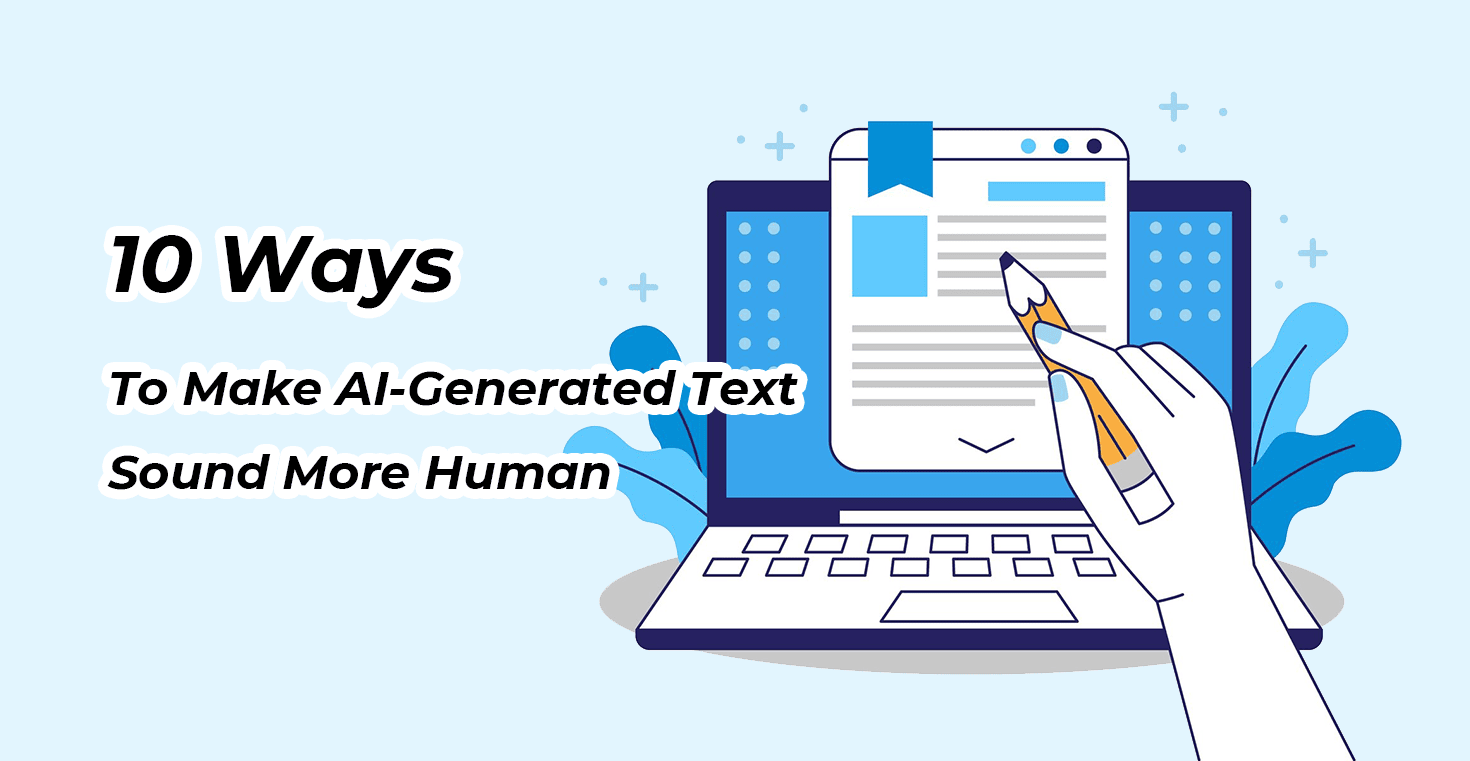Let’s face it: AI writing tools are incredible assistants. They can churn out drafts, outlines, and ideas at lightning speed, saving us precious time and energy. But often, the raw output, while grammatically correct, can feel a bit… well, robotic. It might lack warmth, personality, or that certain something that makes writing truly connect with a reader.
You’ve probably felt it – that slightly sterile tone, the predictable phrasing, the lack of genuine spark. So, how do you bridge that gap? How do you take the efficient foundation AI provides and build something that sounds like it was written by a real, thinking, feeling human being? It’s a common challenge, and thankfully, one you can overcome with some targeted editing. While some tools aim to help automate this, like an AI Text Humanizer, the most effective approach often involves manual refinement focused on specific human elements.
This article dives into 10 practical ways you can edit and enhance AI-generated text to make it sound much more natural, engaging, and authentically human. Think of these as adding the secret ingredients that transform functional text into compelling communication.
Contents
- Why Even Bother Humanizing AI Text?
- 1. Inject Your Unique Voice & Personality
- 2. Vary Sentence Structure (Boost That “Burstiness”)
- 3. Embrace Contractions and Conversational Language
- 4. Tell Stories and Use Analogies
- 5. Load Up on Specific Details and Examples
- 6. Refine Word Choice (Increase Perplexity Naturally)
- 7. Weave In Personal Experience & Anecdotes
- 8. Read It Aloud – The Ultimate Gut Check
- 9. Actively Check and Adjust the Tone
- 10. Focus on Smooth Transitions
- Conclusion: Making AI Your Co-Pilot, Not the Pilot
Why Even Bother Humanizing AI Text?
Before we jump into the “how,” let’s quickly touch on the “why.” Taking the time to humanize AI content isn’t just about fooling detectors; it’s about better results:
- Stronger Connection: Human language, with its quirks and nuances, builds rapport and makes readers feel something.
- Increased Credibility (E-E-A-T): An Authentic voice, personal insights, and clear explanations signal Expertise, authority, and Trustworthiness to both readers and search engines.
- Better Brand Voice: Consistent, human-sounding content reinforces your unique brand personality.
- Improved Readability: Natural language flows better and is simply more pleasant to read.
- Avoiding the “Uncanny Valley”: Text that’s almost human but slightly off can be jarring. Polishing removes that robotic feel.
Okay, let’s get practical. Here are 10 actionable strategies:
1. Inject Your Unique Voice & Personality
AI models are trained on vast datasets, leading them toward a neutral, average style. They don’t have your specific humor, opinions, or way of phrasing things. This is often the biggest giveaway of AI text.
- How to do it:
- Rewrite sentences to sound like you would say them.
- Add your opinions or perspective (where appropriate for the piece). Use “I think,” “In my experience,” or frame statements with your viewpoint.
- Incorporate your brand’s specific tone: Is it witty? Formal? Inspirational? Enthusiastic? Ensure the language reflects this consistently.
- Don’t be afraid of stylistic quirks that are natural to you (within reason and grammatical correctness).
- Relatable Example: Imagine AI writing a product description like: “This product offers significant advantages.” You might rewrite it as: “Okay, let me tell you why I’m genuinely excited about this product…” or “Here’s the deal – this gadget solves that annoying problem you have.” That immediate injection of personality makes a world of difference.
2. Vary Sentence Structure (Boost That “Burstiness”)
Humans naturally vary the length and structure of their sentences. AI can sometimes fall into a pattern of medium-length, similarly structured sentences, making the text feel monotonous. This lack of variation is sometimes called low “burstiness.”
- How to do it:
- Consciously mix short, punchy sentences with longer, more complex ones.
- Break up paragraphs that feel rhythmically flat or have sentences of similar length.
- Start sentences differently. Use varied openings instead of repeating the same subject-verb structure.
- Use questions occasionally to engage the reader directly.
- Analogy: Think of it like music. A song with only one note repeated would be boring. Good writing, like good music, needs rhythm and variation. A short sentence can add impact. A longer one can develop an idea. Mix it up!
3. Embrace Contractions and Conversational Language
Unless you’re writing a very formal scientific paper or legal document, overly formal language can sound stiff and impersonal – a common AI trait.
- How to do it:
- Use contractions: Swap “it is” for “it’s,” “do not” for “don’t,” and “you are” for “you’re.” It instantly makes the text feel more approachable.
- Use simpler words: Replace overly complex or jargony words with plainer language your audience will easily understand (e.g., “utilize” becomes “use”).
- Address the reader directly using “you” and “your.”
- Ask rhetorical questions to draw the reader in.
- When to be cautious: Know your audience and purpose. A research paper requires formality; a blog post usually benefits from a more conversational tone.
4. Tell Stories and Use Analogies
Humans are wired for stories. Narratives and comparisons make abstract concepts tangible and memorable. AI often sticks to dry facts and explanations.
- How to do it:
- Illustrate points with brief anecdotes or hypothetical scenarios. “Imagine you’re trying to…”
- Use simple analogies or metaphors to explain complex ideas. Compare a difficult concept to something familiar.
- Structure sections around a mini-story or case study.
- Relatable Example: Instead of the AI explaining a process with bullet points only, you could introduce it like this: “Learning this felt like trying to assemble IKEA furniture without instructions at first – confusing! But then I realized the key was [Your Analogy/Story leading into the steps].”
5. Load Up on Specific Details and Examples
AI-generated text can often be frustratingly vague. It might say something is “good” or “effective” without explaining why or how. Human writing feels more grounded when it includes specifics.
- How to do it:
- Replace generic adjectives (like “great,” “nice,” and “significant”) with descriptive details. Why is it great?
- Provide concrete examples to illustrate every key point. Show, don’t just tell.
- Include data, statistics, or specific results where applicable (and cite sources!).
- Name names: Mention specific tools, people, or places if relevant and helpful.
- E-E-A-T Boost: Adding specifics is a direct way to demonstrate Experience and Expertise. It shows you know what you’re talking about beyond surface-level generalities.

6. Refine Word Choice (Increase Perplexity Naturally)
While AI has a vast vocabulary, it often defaults to the most statistically common words, leading to predictable text (low “perplexity”). Careful word choice adds depth and nuance.
- How to do it:
- Swap bland verbs and nouns for more vivid, precise, or evocative ones. (e.g., “walked quickly” could become “dashed,” “scurried,” “strode”).
- Use a thesaurus thoughtfully. Don’t just pick a random synonym; choose one that perfectly fits the context and your intended meaning.
- Eliminate unnecessary jargon but use accurate technical terms when needed for clarity with a knowledgeable audience.
- Look for overused “AI-isms“ – common phrases AI models tend to rely on – and reword them.
- The Goal: Not to sound overly academic or obscure but to use language that is precise, engaging, and slightly less predictable than the AI’s default output.
7. Weave In Personal Experience & Anecdotes
Nothing screams “human” like sharing a slice of your own experience. AI can’t replicate genuine lived moments or the insights gained from them.
- How to do it:
- Briefly share a relevant personal story that illustrates a point. “I remember struggling with this exact issue when I first started…”
- Mention lessons learned from your successes or failures related to the topic.
- Frame advice based on your experience: “What worked well for me was…”
- Connect with the reader’s potential experience: “Perhaps you’ve also felt frustrated by…”
- Authenticity Check: Ensure anecdotes are relevant and concise, supporting the point rather than derailing it. This is a powerful E-E-A-T signal, showcasing real Experience.
8. Read It Aloud – The Ultimate Gut Check
This might be the simplest yet most effective tip. Your ears can catch awkward phrasing, unnatural rhythms, and robotic sentences that your eyes might skim over.
- How to do it:
- Literally read your edited text out loud. Listen to how it flows (or doesn’t).
- Does it sound like something a real person would say?
- Are there any clunky sentences that make you stumble or sound breathless?
- Is the rhythm varied? Or does it sound monotonous?
- If it sounds weird when spoken, it will likely feel weird when read. Go back and revise those awkward sections until they flow naturally off the tongue.
9. Actively Check and Adjust the Tone
AI often defaults to a neutral, helpful, slightly formal tone. But does that tone actually fit your specific article, audience, and purpose?
- How to do it:
- Define the desired tone before you start editing (e.g., encouraging, authoritative, urgent, humorous, empathetic).
- Read through the edited text, specifically listening for tone. Does the word choice, sentence structure, and overall feel match your goal?
- Adjust specific words and phrases that feel out of sync with the intended tone. Maybe add more enthusiastic language, or perhaps adopt a more serious and direct approach.
- Example: If the AI draft sounds like a dry instruction manual, but you want an encouraging tutorial, you’ll need to inject words of support, anticipate user frustrations, and adopt a friendlier style.
10. Focus on Smooth Transitions
Humans naturally guide readers from one idea to the next using transition words and logical connections. AI can sometimes jump between points abruptly, making the text feel disjointed.
- How to do it:
- Check the flow between sentences. Does one logically follow the previous?
- Check the flow between paragraphs. Is there a clear connection or link from the end of one paragraph to the start of the next?
- Add transition words and phrases where needed (e.g., “However,” “Furthermore,” “In contrast,” “As a result,” “Another key point is,” “Building on that idea…”).
- Ensure your overall argument or narrative progresses logically from start to finish.
- Think of transitions as signposts helping the reader follow your train of thought easily.
Conclusion: Making AI Your Co-Pilot, Not the Pilot
AI writing tools are phenomenal starting points, idea generators, and efficiency boosters. But raw AI output rarely has the nuance, personality, and warmth of human writing. By consciously applying these ten techniques – focusing on voice, rhythm, specificity, storytelling, and flow – you can elevate that functional AI draft into content that truly resonates.
It’s not about ditching AI; it’s about using it smartly as a co-pilot while you remain firmly in the pilot’s seat. Injecting your humanity is what builds connection, establishes trust, and ultimately makes your writing more effective and enjoyable to read. So, take that AI draft, roll up your sleeves, and make it undeniably, authentically yours.

